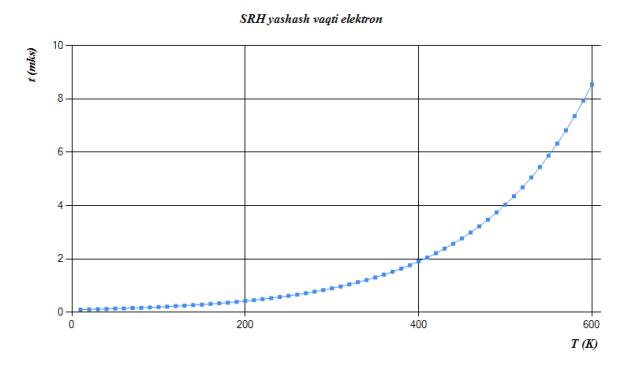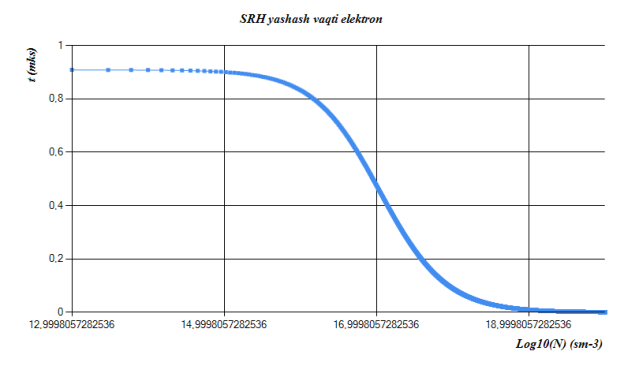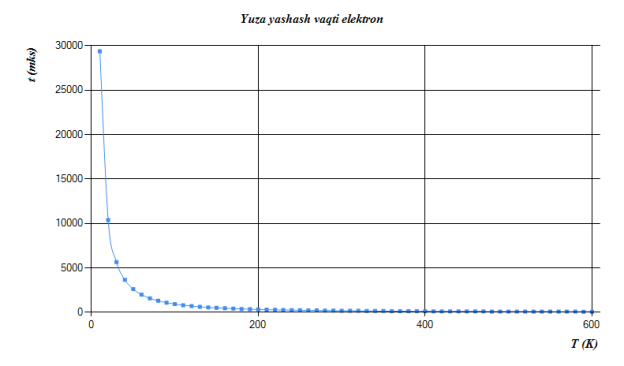In this article, describe analyzing theoretically temperature and doping dependence electron and hole lifetimes in silicon bases solar cells.
Key words: lifetime, silicon, temperature, model, donor, acceptor
Solar cells are now becoming the main source of energy. Because the world is running out of non-renewable energy sources. The best solution for the economy at this time is, of course, renewable energy sources. There are many types of solar cells. The cheapest of these are silicon-based solar cells. Silicon is one of the most common cells in the world. We need to know more about the internal properties of the solar cell in order to increase its efficiency. For example, when electrons and holes age, what is the efficiency of solar cells? Of course, if you have a long life. No feature is self-explanatory. They, in turn, are inextricably linked to many processes.
The lifetime is the time between particle generation and recombination. So to know more about life expectancy, we need to know more about recombination and generation.
Generation is the process of forming electrons and holes. There are many types of generations. Avalanche, thermogeneration and photogeneration.
Photogeneration is the process of generating light. Its mechanism is based on the photo effect. But the photo effect is also divided into two. Internal and external photo effect. An event in the solar system can be called an internal photo effect. It is called the photovoltaic effect by another name. Photogeneration in solar cells depends on the wavelength of light and the thickness of the solar cell, as well as the surface area of the solar cell [2].
 (1)
(1)
 (2)
(2)
![]() (3)
(3)
Recombination is the reunification of electrons and holes. There are three main types of recombination. SRH, Auger, Radiation and surface recombination.
In silicon-based solar cells, the main part of recombination consists of SRH, Auger and surface recombination. This is because radiative recombination occurs only in solar cells made of substances with a properly restricted zone. An example of this is GaAs.
![]() (4)
(4)

Fig. 1. Temperature dependence of the auger lifetime of an electron in a silicon-based solar cell
Auger recombination is strongly related to the concentration of the input, and the mechanism of its formation is as follows. The pair of electrons descends from the conduction band to the valence band, and one of them absorbs the energy and returns to the conduction band [1].
![]() (5)
(5)
 (6)
(6)
 (7)
(7)

Fig. 2. Temperature dependence of the SRH recombination time of electrons in silicon-based solar cells
Recombination of SRH depends on the defects, and the process of its formation is as follows. The electron in the conduction band first falls to a defective surface, then emits a phonon again, falls into the valence band, and joins the cavity [1].
 (8)
(8)
 (9)
(9)
 (10)
(10)
 (11)
(11)

![]() (12)
(12)
![]() (13)
(13)
![]() (14)
(14)
Each recombination process determines the lifetimes of electrons and holes. That is, the less recombination, the longer the lifespan.
Fig. 3. Dependence of the SRH lifetime concentration of electrons in silicon-based solar cells on the input concentration
Another type of recombination is surface recombination, which occurs mainly on the surface of the solar cell. To get rid of this, the surface of the solar cells is passivated [3].
 (15)
(15)
The rate of recombination depends on the concentration of impurities on the surface and is expressed as follows.
 (16)
(16)

Fig. 4.Temperature dependence of the lifetime of electrons in silicon-based solar cells
Nowadays, technology is evolving, which makes it easier for us to perform calculations. We also created a program called “Suntulip-2 for silicon solar cell” to perform the above theoretical calculations in C # 6.0 programming language. All of the above values are obtained in this program. In short, in order to prolong the life of solar cells, we must first reduce the amount of recombination.
References:
- D. J. Roulston, N. D. Arora, and S. G. Chamberlain, “Modeling and Measurement of Minority-Carrier Lifetime versus Doping in Diffused Layers of n+-p Silicon Diodes,” IEEE Transactions on Electron Devices, vol. ED-29, no. 2, pp. 284–291, 1982.
- J. G. Fossum et al., “Carrier Recombination and Lifetime in Highly Doped Silicon,” Solid-State Electronics, vol. 26, no. 6, pp. 569–576, 1983.
- R. F. Pierret, Semiconductor Device Fundamentals. Prentice Hall, 1996.







